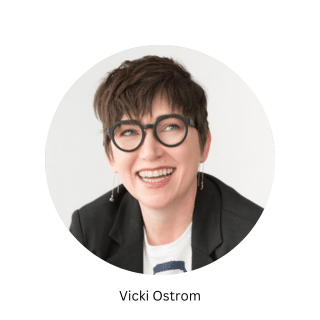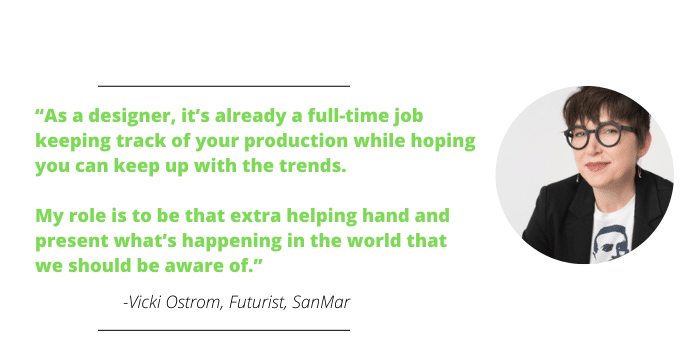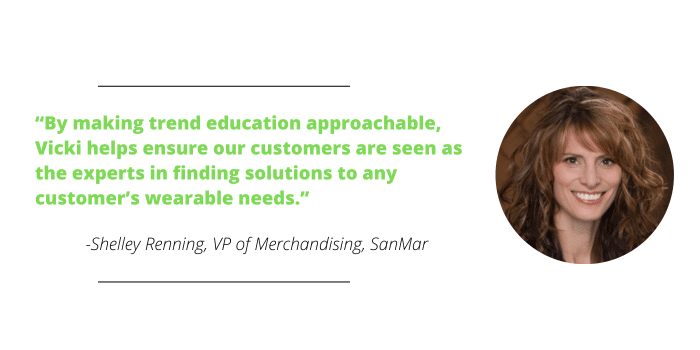What will be fashionable in the fall of 2025? Vicki Ostrom’s job is to have that answer today.
A 12-year veteran of the promotional products industry, Ostrom is a “futurist” at SanMar (PPAI 110788, S16) – promo’s leading supplier in this year’s PPAI 100. Her role is to supplement the research and knowledge that the Issaquah, Washington-based firm’s merchandising, design and product creation teams obtain from vendor partners, customers, shopping and other sources.
“You want to design something that will be in our line for at least five years, but of course, fashion does change,” Ostrom says. “How do you design a universal style that’s not only trendy for now and five years from now, but also super durable and for potentially a range of ages and ethnicities? You have to really think it through and put a lot of factors into play to decide what that garment should look like.”

The Montana native has always been drawn to making something from scratch.
The daughter of a wheat farmer, Ostrom initially wanted to be a chef. Mixing colorful ingredients sparked her creativity, fueling her interest in the arts. Although she went to college for acting, costume design truly resonated with her.
“You have to learn about every character, understanding the minutia of who’s around them, what’s the setting they live in and how does that affect what they wear,” Ostrom says.
- Graduating from the University of Montana with a Bachelor of Fine Arts in technical theatre, she spent seven years as a costume designer and seamstress on Broadway in New York City.
Envious of friends who had a stable career with healthcare coverage and a 401(k) plan, she relocated with the intention of earning a master’s in costume design at the University of Washington. However, Seattle Central College offered a similar education for a shorter amount of time and a lot less money, so she earned an associate of applied science in apparel design and went on to work for high-profile brands, like Eddie Bauer, Tommy Bahama and JCPenney.
“I was mainly designing apparel for men,” Ostrom says. “You have to be extremely good with your research because men don’t mess around when it comes to clothing. If they love it, they’ll buy a lot of it. If they don’t, you’ll never see them again.”
Entering The Promo World
In 2011, Ostrom joined SanMar as a senior designer.
“We were just starting to really do a deep dive focus into women’s clothing,” she says. “Up to that point, if you had a woman on your team, probably a small men’s shirt would be fine. But then Instagram and Pinterest were coming into play, so women everywhere were starting to see and be able to buy clothing from outside their region with ease. We readdressed all the fits we had in women’s product and examined new styles.”
Comparing SanMar’s women’s apparel to that of popular retail brands, Ostrom was impressed at the quality, and thought others would be, too.
- So, she produced editorial pages with images of product designs and matched them with trends happening in the world.
- The sales team quickly took notice and wanted to show their customers.
- The content was so valuable that she transitioned into her current full-time role as trends editor at SanMar.
While apparel trends are certainly related to the latest wearable fashions, most folks don’t consider that what we choose to wear comes from larger influences from the world around us, according to Shelley Renning, vice president of merchandising at SanMar.
“One of Vicki’s contributions to SanMar’s team of designers and merchandisers is to share those macro trends in a way that can be translated into functional and trend-right products that resonate with end users,” Renning says.

Indeed, Ostrom aims to bring macro-level observations of generational shifts, economic factors, health and wellness movements, climate change, how other industries are moving and anything else existential like a pandemic or war that could create opportunities – either for new products or for enhancing products, categories and brands that SanMar currently designs for.
“I love the social anthropology of trend reporting,” Ostrom says. “It’s all about researching your customer. As a designer, it’s already a full-time job keeping track of your production while hoping you can keep up with the trends. My role is to be that extra helping hand and present what’s happening in the world that we should be aware of.”
Connecting The Dots
Predicting the next big thing in fashion requires endless research. Working from home, Ostrom’s daily routine includes reading both the digital and print version of The New York Times, poring through global trend resources that SanMar subscribes to, conversing with colleagues about what they’re reading, seeing or hearing, watching The Today Show and even studying the commercials.
“As a marketer, it’s a difficult job to get someone’s attention and present something that would be informative and captivating enough to have them actually watch a commercial,” Ostrom says. “I see what colors and images they’re using and what stories they’re choosing to tell.
“Over the years, I’ve been able to see different aspects of things I read from different sources and make more connections to understand what’s a true trend we’re pursuing as a society rather than a really strong advertorial that some company is putting out.”
- The biggest trend Ostrom is seeing right now is companies selling their products through the lens of education.
“People are really into learning right now – they want to understand things,” she says. “So, companies are teaching their customer something, and the customer appreciates that they’ve just learned something valuable.”

Ostrom attributes her success to her innate curiosity and her penchant for always paying attention to the world around her.
“Because everybody is so busy in their lives maybe they’re not sitting down and making those connections the way I do for my job,” she says. “What makes me successful is the volume of places I look: museums, TV shows, movies, economy stories, etc. Seeing a volume of different types of sources of information and then making your own conclusions about where you’re seeing these threads come together gives you confirmation that you’re following the right path.”


